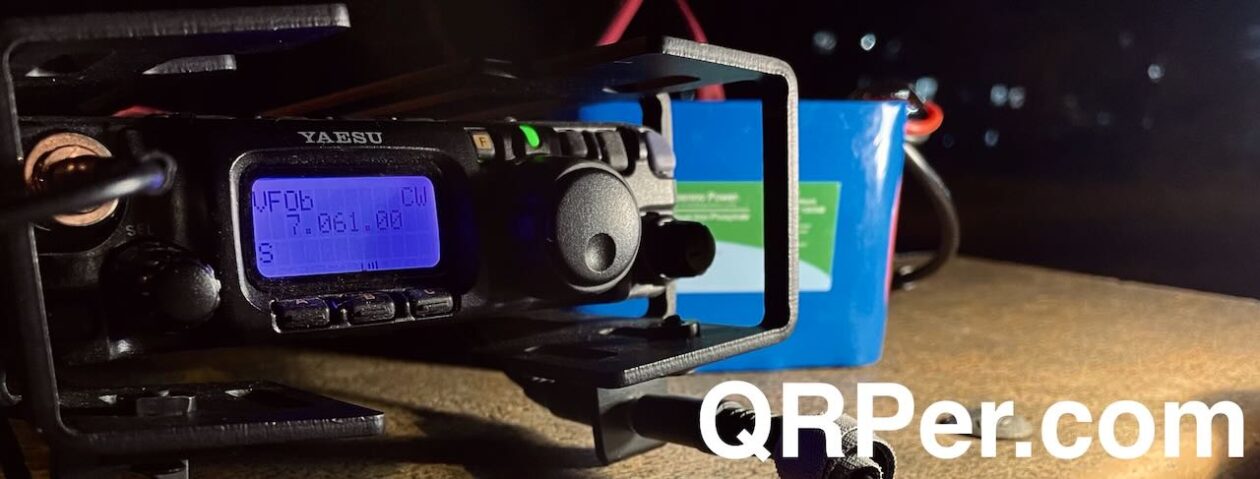Many thanks to Brian (K3ES) who shares the following guest post:

Building and Testing the VK160 Antenna
by Brian (K3ES)
The ability to set and achieve long- and short-term goals keeps me interested and active in the Parks on the Air (POTA) program. Often these goals are associated with POTA awards. Currently, I am working slowly to complete the activator version of the James F. LaPorta N1CC award, which requires an activator to make QSOs on 10 amateur bands from 10 different parks. With my operating style, I have found it achievable to make QSOs on the 9 available HF bands (80m, 60m, 40m, 30m, 20m, 17m, 15m, 12m, and 10m), and this has become easier with the rising solar cycle. I have completed QSOs on non-HF bands using 2m and 70cm simplex. The other options to pick up 10th band QSOs include the 6m band and the 160m band.
I have found it difficult to make unscheduled POTA contacts on 2m and 70cm, and scheduled contacts can be difficult to arrange in parks that are remote from population centers. I have built a 6m antenna, but contacts are seasonal (and for me very elusive). So I started looking for a way to add 160m capability to my portable station. Ultimately that resulted in homebrewing a new antenna that I now call the VK160, and here is its story.
Objective
I needed a field-deployable 160m antenna. My operating style requires that the antenna system be both light and compact. QRP power levels are sufficient for my purposes. I am very comfortable deploying wire antennas in the Pennsylvania woods, and QRP wire antennas can be both light and compact. I have found that end-fed antennas are simpler to deploy in the field, because they can be configured as an inverted V or as a sloper, using only one point of support.
An end-fed half wave (EFHW) antenna would be naturally resonant, but would need to be over 250 ft (76m) long. A wire antenna of that length would be challenging to deploy, even in more open areas. So, I decided to pursue a 9:1 unun-based end-fed “random wire” (EFRW) antenna. In fact, I have two commercial EFRW antennas available, but have never been successful in tuning them for 160m using the ZM-2 tuner in my field kit. So, I concluded (probably incorrectly, but more on that later) that I needed to build a 9:1 random wire antenna with a longer radiating element than the 71 ft wire built into my largest existing EFRW. I also wanted to build this antenna myself, using available components, so that it would be both inexpensive and customized to my needs.
I broke the task into four parts:
First, I needed to build a 9:1 unun suitable for use at QRP power levels. The 9:1 unun is an autotransformer that reduces antenna feedpoint impedance by a factor of 9, hopefully a level that a wide-range tuner can match to the 50 ohm transceiver impedance.
Second, I had to design and build mechanical elements of the antenna system, incorporating the electrical components needed for the feedpoint.
Third, I needed to select a suitable non-resonant wire length for the radiator.
Finally, I needed to deploy and test the finished antenna on the air. If successful, testing would culminate in completing an on-air QSO with the antenna being driven at 5 watts or less.
Building the 9:1 Unun
While I have built successful 49:1 ununs as the basis for EFHW antennas, I had no experience building 9:1 ununs. Accordingly, I started with the ARRL Antenna Book, then a web search. VK6YSF’s excellent web page provided very detailed instructions for 9:1 unun construction. His 9:1 Unun design was based on a FT140-43 toroid wrapped with heavy gauge magnet wire, with design power rating around 100 watts. My application was focused on 10 watts maximum, and I wanted a lighter-weight solution to the unun design.
Looking at the components I had available, I found FT50-43 toroids and 24 AWG magnet wire in my inventory. I had used those during construction of successful 49:1 EFHW antennas. The VK6YSF design, built with the smaller toroids and lighter magnet wire, seemed to be a good (and cheap) starting point.

The next problem that presented itself was a problem with translating the winding technique to smaller wire and a smaller toroid. Put simply, my fingers do not have the dexterity to wrap three parallel 24 AWG wires around a ½ inch OD toroid without getting them crossed, twisted, or worse. So, why not twist the three conductors from the start, and wrap the toroid with “trifilar” windings? It would be simple enough to identify the mating wire ends after wrapping, just with a set of continuity tests. That would facilitate proper connection of the wires to yield the final auto-transformer configuration.

I posed the “trifilar” winding question to my friends over on the QRPer.net discussion board. Nobody identified a significant flaw with the proposed method, but neither did anyone have experience that would assure success. So, I decided to use the “trifilar” winding technique to construct my 9:1 unun, with the full recognition that its success would be uncertain, and only proven by testing the finished product. Continue reading In Pursuit of the Top Band: Brian describes how he built and tested a field-portable 160 meter EFRW antenna
